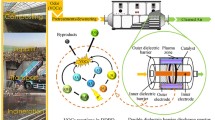Abstract
As a kind of volatile organic compound, styrene is a typical industrial pollutant with high toxicity and odorous smell. In this study, the removal of malodorous styrene simulation waste gas was carried out in a self-made wire-tube dielectric barrier discharge reactor. The decomposition efficiency of the reaction was investigated under different applied voltages and flow rates. The results showed that nearly 99.6 % of styrene could be removed with a concentration of 3,600 mg/m3 and the applied voltage of 10.8 kV. However, the selectivity of CO2 and CO showed that the mineralization efficiency of styrene was less than 25 %. The by-products of the reaction, including O3, NO x and other intermediates, were also detected and analyzed under different applied voltages. The relationships between the applied voltage and the quantity of final product (CO2) and by-products (intermediate organics, NO x , O3) were investigated. The reaction mechanism was also described according to the bond energy and the intermediates that formed.








Similar content being viewed by others
References
C. Garcia-Diego, J. Cuellar, Chem. Eng. J. 139, 1 (2008)
C.L. Huang, H.Y. Zhang, Z.Y. Sun, Y.F. Zhao, S. Chen, R.T. Tao, Z.M. Liu, J. Colloid Interface Sci. 364, 2 (2011)
R. Rosiah, N.M. Mahmoud, S. Hamdani, Chem. Eng. J. 132, 1–3 (2007)
T.C. Morata, M. Sliwinska-Kowalska, A.C. Johnson, J. Starck, K. Pawlas, E. Zamyslowska-Szmytke, P. Nylen, E. Toppila, E. Krieg, N. Pawlas, D. Prasher, Int. J. Audiol. 50, 10 (2011)
S. Wongvijitsuk, P. Navasumrit, U. Vattanasit, V. Parnlob, M. Ruchirawat, Int. J. Hyg. Environ. Health 214, 2 (2011)
P.E. Russell, B. Ellis, D.M. Abrams, in Land Reclamation: Extending the Boundaries, ed. by H.M. Moore, H.R. Fox, S. Elliott (Swets & Zeitlinger, Lisse, 2003), p. 351
J.G. Bendall, J. Food Prot. 70, 4 (2007)
C.L. Chang, H. Bai, S.J. Lu, Plasma Chem. Plasma Process. 25, 6 (2005)
F. Adam, A. Lqbal, Chem. Eng. J. 160, 2 (2010)
B. Boulinguiez, P. Le Cloirec, Energy Fuels 24, 9 (2010)
X. Wang, X.Q. Jia, J.P. Wen, Chem. Eng. J. 159, 1–3 (2010)
H.M. Lee, M.B. Chang, Plasma Chem. Plasma Process. 23, 3 (2003)
M.B. Chang, S.J. Yu, Environ. Sci. Technol. 35, 8 (2001)
J.H. Niu, A.M. Zhu, C. Shi, L.L. Shi, Z.M. Song, Y. Xu, Chin. J. Catal. 26, 9 (2005)
H.B. Ma, P. Chen, M.L. Zhang, X.Y. Lin, R. Ruan, Plasma Chem. Plasma Process. 22, 2 (2002)
A. Nasonova, D.J. Kim, W.S. Kim, K.S. Kim, Res. Chem. Intermed. 34, 4 (2008)
J. Chen, J.T. Yang, H. Pan, Q.F. Su, Y.M. Liu, Y. Shi, J. Hazard. Mater. 177, 1–3 (2010)
Y.H. Bai, J.R. Chen, X.Y. Li, C.H. Zhang, Rev. Environ. Contam. T (2009). doi:10.1007/978-1-4419-0032-6_4
J. Meichsner, Lect. Notes phys. (2005). doi:10.1007/11360360_5
C.H. Subrahmanyam, M. Magureanu, A. Renken, L. Kiwi-Minsker, Appl. Catal. B 65, 1–2 (2006)
F. Holzer, U. Roland, F.D. Kopinke, Appl. Catal. B 38, 3 (2002)
X.M. Zhang, J.B. Zhu, X.Y. Li, Z. Liu, X.W. Ren, K.P. Yan, IEEE Trans. Plasma Sci. 39, 6 (2011)
Q. Tang, W.J. Jiang, Y. Cheng, S. Lin, T.M. Lim, J. Xiong, Ind. Eng. Chem. Res. 50, 17 (2011)
Acknowledgment
This work was financial supported by National Key Technology R&D Program (2010BAK69B24), Shanghai Science and Technology Committee (10dz0583205) and Natural Science Foundation of China (Project No. 41173108).
Author information
Authors and Affiliations
Corresponding author
Rights and permissions
About this article
Cite this article
Zhang, H., Li, K., Sun, T. et al. The removal of styrene using a dielectric barrier discharge (DBD) reactor and the analysis of the by-products and intermediates. Res Chem Intermed 39, 1021–1035 (2013). https://doi.org/10.1007/s11164-012-0664-0
Received:
Accepted:
Published:
Issue Date:
DOI: https://doi.org/10.1007/s11164-012-0664-0




